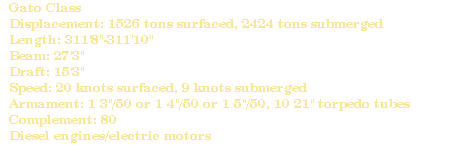

 |
|---|

I have been struck with the one singular thought that a ship with such a well regarded war record could have come and gone so quickly and left such a little mark on history. The common man when asked about the submarines of WW II will quickly call up the names of Tang and Wahoo, Growler and Barb. These ships deserve to be remembered, don't get me wrong. They all had good records and a total of 52 boats and crews gave their all. ( They remain on "Eternal Patrol" as we say in the Submarine Service. ) But the ship with the tonage record for the whole war and the record for tonage sunk in one action has passed into oblivion. Since I had the honor to sail on her namesake, the USS Flasher SSN 613, I f eel it is my duty to try and inform those of you who may have never heard of this fine vessel. This an incompleate history. As more is learned, it will be placed up here for you to read. |

|
|---|
Built by the Electric Boat Company, Groton, Connecticut, the USS FLASHER (SS 249) was launched on 20 June 1943. Mrs. W. A. Saunders of New London, Connecticut, wife of a Navy Cross winner who was serving in the submarine service at that time, was the spo nsor. FLASHER was commissioned on 25 September 1943 at the U. S. Naval Submarine Base, New London, Connecticut. Lieutenant Commander Reuben T. Whitaker served as her first commanding officer. |

|
|---|
FLASHER proceeded to Pearl Harbor from New London, CT and arrived on December 15th, 1943 and outfitted for her first war patrol. FLASHER commenced her first war patrol from Pearl harbor on January 6th, 1944 and headed to her patrol area off the coast of Mindoro Island in the Philippines. On January 18th, 1944, FLASHER sank her first ship, a 2.900 ton former gunboat. On February 5th FLASHER sank a freighter off shore from Manila and then again sank two more vessels from the same convoy on February 14th. FLASHER proceeded to Fremantle, Western Australia and arrived on February 29th for her first post partol refit, after 54 days, and having sunk 10,528 tons of enemy shipping. FLASHER's second war patrol commenced on April 4th, 1944 and took her to her assigned area off the French Indochina coast. A river gunboat named TAHURE, (an ex - French Arras class small escort), was escorting a freighter near the Hon Doi Islands on April 29th and FLASHER sank them both. After sinking a large cargo ship in the Sulu Sea 3 May, FLASHER shaped course for Fremantle, arriving 28 May for refit until 19 June. On May 21, nausea was gripping everyone on board ANGLER, (SS-240).
The situation was reported to Fremantle, and the submarine was ordered
to return at once. Things on board ANGLER continued to grow worse. On 22
May, Lcdr. Olsen noted in the log: "Phy sical condition of officers and
crew is so bad that it is difficult to maintain watch, either surfaced
or submerged. Put crew on fruit juice alone, no water. Held thorough field
day in case boat is contaminated. Exercised special supervision in cooking,
d ishwashing." On 23 May he wrote, "Decided to run submerged as we did
not have enough able-bodied people to maintain proper surface watch."
FLASHER made her third war patrol in the South China Sea, where on 28 June 1944 she contacted a heavily escorted convoy of 13 ships. She made a cautious approach, undeterred by the escort, and shortly after midnight 29 June, broke into the convoy to sink a freighter and badly damage a large passenger-cargo ship. FLASHER, ANGLER and CREVALLE fromed up to be one of the first "wolf pack" patrols of the war. FLASHERS next victim was a freighter, sunk 7 July. Twelve days later, FLASHER sighted the Kuma class cruiser OI* escorted by a destroyer. Two attacks, each followed by a heavy depth charge retaliation from the destroyer, sufficed to sink this choice target, a fact confirmed several hours later when a periscope observation revealed only the destroyer in si ght. Seven days later, she sank another important target, a merchant tanker, and the same day damaged another tanker later sunk by one of her sisters. With all her torpedoes gone, FLASHER put back for Fremantle, where she replenished and refitted between 7 and 30 August. *The Oi was built in 1921 and looked like a glorified torpedo boat carrying 40 24" torpedo tubes. I f she had ever been able to get in to the middle of a convoy she might have wrecked havoc with the shipping. In the Japanese language Oi means: "Greater Fountain". During her fourth war patrol, in the Philippines, FLASHER headed a coordinated attack group which included two other submarines, . Although she was on lifeguard station during the air attacks preliminary to the invasion of the Philippines during part of this patrol, Flasher sank three ships, a former light cruiser on 18 September, a transport on 27 September, and a cargo ship on 4 October. She returned to Fremantle 20 October. All in all the second, third and fourth war patrols were eminently successful bringing FLASHERS score up another 46,985 tons. Heading the same attack group, of HAWKBILL and BECUNA, FLASHER now commanded by Lieutenant Commander G. W. Grider, sailed on her fifth war patrol 16 November 1944, bound for Camranh Bay. On 4 December one of her companions reported a tanker convoy, and Fl asher set a course which would bring her to the target. As she made her approach in a heavy downpour, a destroyer suddenly loomed up before her, and Flasher launched her first spread of torpedoes at this escort. The destroyer was stopped by two hits, and began listing and smoking heavily. Flasher got a spread of torpedoes away at a tanker before she was forced deep by a second destroyer, which dropped 16 depth charges. Rising to periscope depth, Flasher located the tanker burning and covered by yet a thir d destroyer. Speedily reloading, she prepared to sink the destroyer and finish off the tanker, and though almost blinded by rain-squalls, she did just this with a salvo of four torpedoes, two of which hit the destroyer, and two of which passed beneath her as planned to hit the tanker. Once more, counter-attack forced Flasher down, and when she surfaced she found no trace of the two damaged destroyers. The tanker, blazing away, was still guarded by three escorts until abandoned at sunset, when Flasher sank her with one torpedo. The two destroyers, both found after the war to have been sunk, were the Yugumo class KISHINAMI and the IWANAMI, (the last I can't not find out at this time which class of destroyer she was; Jentschura, Jung and Mickel's definitive work on the IJN lists no combatant vessel with that name). Flasher contacted another well-guarded tanker convoy on the morning
of 21 December 1944, and she began a long chase, getting into position
to attack from the unguarded shoreward side. In rapid succession, Flasher
attacked and sank three of the tankers, re ceiving no counter-attack since
the enemy apparently believed he had stumbled into a minefield. One of
these tankers was the largest she sank during the war, the other two, of
the same displacement, were tied for third-largest.
|
| January 15, 1945 Flasher Crew Party Photos |
After the fifth patrol, FLASHER was overhauled in San Francisco just seventeen months after leaving New London. During this brief period she had sunk or damaged an estimated 152,000 tons of enemy shipping. By directive dated January 1947 FLASHER was pla ced out of commission in reserve, attached to the U. S. Atlantic Reserve Fleet. |
 |
|---|
 |
 |
 |
|
 |
 |
 |
|---|
FLASHER
earned six Battle Stars on the Asiatic-Pacific Area Service Ribbon for
the war patrols she conducted during the period 6 January 1944 to 13 March
1945. She was awarded the Presidential Unit Citation in recognition of
heroism during the third, fou rth, and fifth patrols. She was officially
credited with sinking more tonnage of Japanese shipping than any other
submarine during World War II (100,230 tons, 24 vessels) and was the only
submarine officially credited with exceeding the 100,000 ton mark.
Flasher was decommissioned March 16, 1946 and "mothballed". On June 1, 1959 the USS Flasher SS 249 was "struck" from the Navy records. She was sold for scrap on June 1, 1963. The conning tower was removed and placed on display as a Memorial at the entranc e to Nautilus Park, a Navy housing area in Groton, Connecticut. The USS FLASHER SSN 613 has also passed into history, like her namesake, having undergone the cutters torch. As of Sept. 30, 1993 she was listed as being disposed of through the SRP, (Ship Recycling Program), at Bremerton Naval Shipyard, Bremerton, Washington. |
| If you would
like to read more about the USS Flasher and her fantastic crew and the
harrowing war patrols please purchase this book. It is written by the son
of the last Executive Officer who server on all seven war patrols.
WAR PATROLS OF THE USS FLASHER
William McCants, 1015 Atlantic Blvd,
Suite 249, Atlantic Beach, FL, 32233 for $27+$3SH.
This book has been endorsed by Capt. Edward Beach, Adm Galantin, Cmdr Alden. This boat with it's two daring skippers holds the record for tonnage sank in WWII.
Sounds of a Diesel Powered Submarine Diving This may take a few minutes to download, but well worth it. Go ahead and click on it and keep on surfin' You can hear the order to "clear the bridge" and the sounds of the mens feet as they decend the ladder and the roar in the background of various machinery and the sound of air rushing out the Main Ballast Tank Vents. There is a sonar ping or two and then , once the sub is submerged, the order to "open the bulkhead flappers and recirculate" meaning to open the air conditioning ducting between compartments. |
|
|
